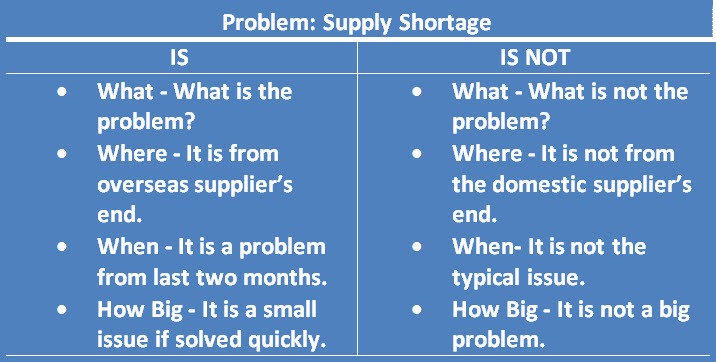If you are not well informed about it then is is not analysis is also a problem solving tool used to solve issues in similar way as FMEA, Correlation, 5 Whys, Brainstorming, Affinity Diagram, Tolerance Analysis, PDCA, and several other techniques. Basically, it is a tool for solving the problems by explaining the sensible and judicious procedure to find the root cause of the problem.
The technique prevents the user from leaping to an untrue cause. If anyone conducts this exercise, then the user will get a confirmed root cause which will assist in creating a plan to solve the issue and prevent it from recurring.
In simple words, it is the necessary tool which leads you to find the accurate cause of a problem. It is a simple method to focus and narrow down the confusions successfully by understanding “What It Is” and What It Is Not.”
For instance, if there is a problem from supplier’s end, then it is not a problem within the organization. It is an external problem from supplier’s side. It is not a problem from domestic supplier side but overseas suppliers. It is a problem with nuts, it is not a problem with bolts, and it keeps going on. Therefore, it remains to ask the questions until and unless you hit the root cause of the problem.
We hope the concept is clear now. Let’s move on towards the focus of this article, how to conduct an is/is not analyses.
Here’s How You Can Conduct an Is Is Not Analysis
It is a straightforward yet very effective tool. You can conduct the is is not analysis to comprehend the problem and the extent of it. Before diving to solve a problem in a hurry, every problem-solving method vouch for spending some significant time to understand, analyse, and plan the action.
The Basics
To begin with, you have to draw two columns on a whiteboard, computer screen, or paper. Next, you will write “IS” in the left column and “Is Not” in the right one. You will write questions like What, Where, When, and How Big is the problem and answer them in the relevant “Is” and “Is Not” column. Here is a simple sample of a basic diagram below:

Above table depicts that how you keep on asking questions. Do not forget to describe the problem in a couple of words. So, after adding the “Is” and “Is Not,” write relevant items in “Is” and “Is Not” section. You can add your answers in either column as applicable. If there is a close decision, then you can also add a few examples to explain what falls on either side of the line.
Summary
It is not the conventional analysis which let you deliberately think about the issue and in specific the limitations of what it is, and what it is not. Hence, it assists you in keeping focus, paying attention, and ultimately results in finding the root cause of the problem. It is a very common problem that unclear limits can lead to rambling off the track and solving the not so important issues.






